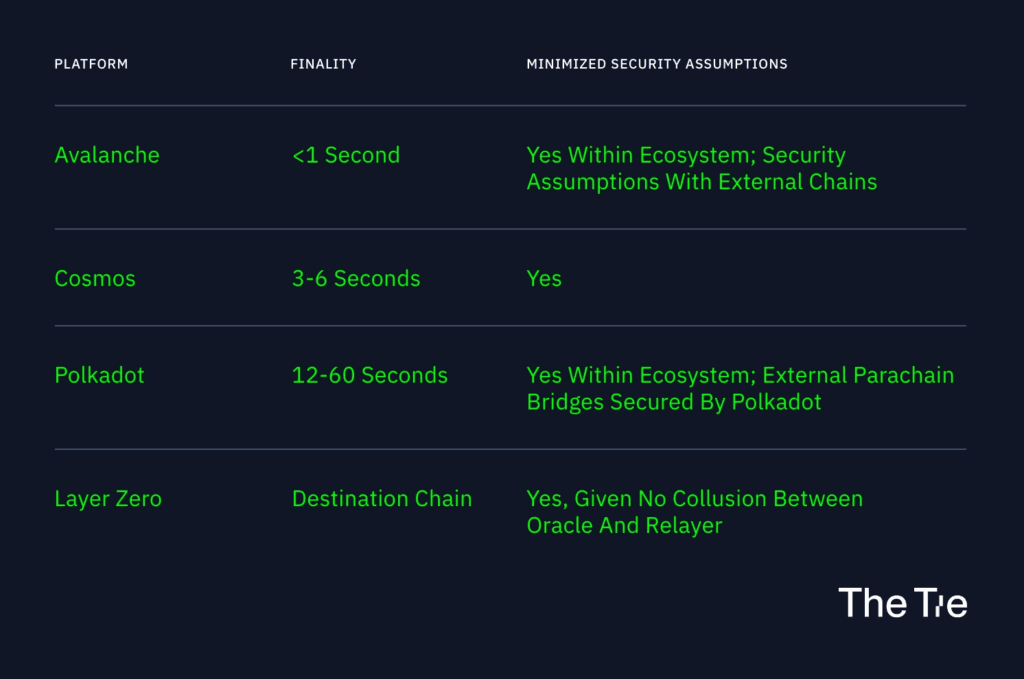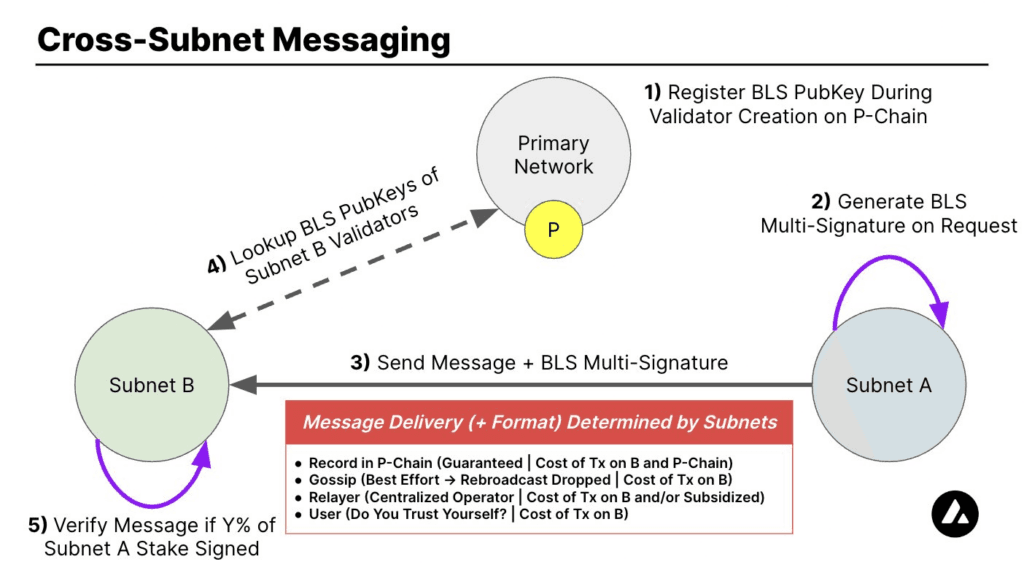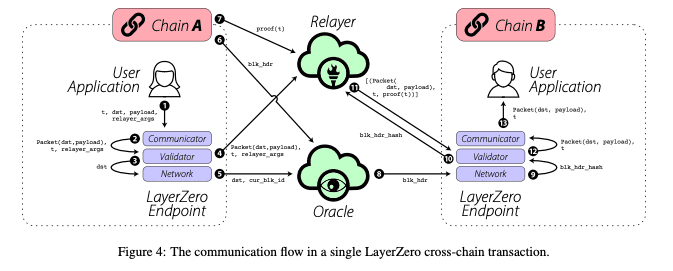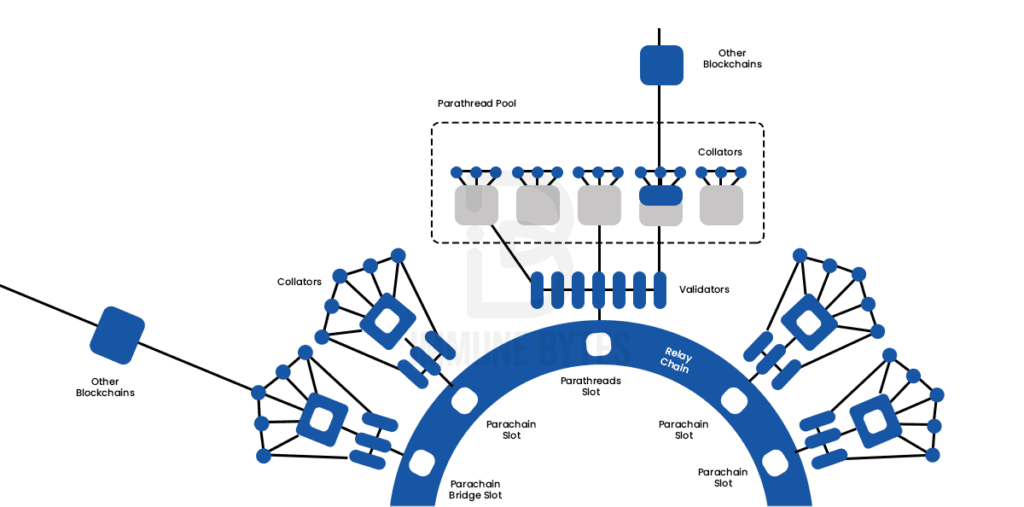In late December, Ava Labs released a new primitive to the Avalanche platform called Avalanche Warp Messaging (AWM). AWM solidifies Avalanche's position as a Layer 0 (L0) blockchain platform, providing a propitious moment to assess its standing within the broader realm of L0 solutions. The aim of this article is to contextualize AWM by delineating the underlying purpose and overarching narrative of Layer 0 (L0) systems, as well as establishing a framework for evaluating L0 blockchains. Subsequently, a comparative evaluation of popular L0 blockchains is conducted in accordance with this framework, and a forward-reaching outlook is presented on the potential for interoperation among these L0s in the future.
The Tie Research
Avalanche Warp Messaging and The Future of Interoperability
Introduction
Layer 0 Primer
L0 blockchain platforms establish a network of interoperable blockchains through a standardized communication protocol. In other words, L0s are the mechanisms by which independent blockchains send messages and initiate transactions on other blockchains. Through L0s, users can transfer assets or messages from one blockchain to another and establish channels for liquidity flow.
The primary service that L0s provide is reducing or eliminating the risk of insecure bridges with potentially highly valuable vaults. A bridge is an application that facilitates transactions between blockchains. To transfer assets without an L0, bridges often store source blockchain assets in a bridge smart contract (vault) to mint a synthetic representation of those assets on the destination chain. Over time, these kinds of bridges collect value and become more appealing attack vectors. Crucially, these bridges assume the economic security of the weakest link among the source blockchain, the bridge, and the destination blockchain. Unfortunately for decentralized finance (DeFi) users, the bridge is the often weakest link, and insecure bridges have led to some of the largest hacks in DeFi.
L0s play an important role in the app-chain thesis - the thesis that the most efficient method of scaling blockchain networks is through the deployment of autonomous Layer 1, application-specific blockchains (app-chains). Some L0 platforms provide benefits to app-chains by allowing virtual machine customization, having cheaper fees, and isolating network activity from other projects in the ecosystem.
In the app-chain thesis, time-to-finality plays an important role in the user experience, especially in the creation of composable services (services that can be sequentially strung together to form a composite service). This is because a transaction must finalize on the source blockchain before subsequent blockchains can be called. Consequently, finalization times compound over blockchain jumps. For instance, if a composite service is composed of three calls on different blockchains, the end user must wait for the finalization time of three blockchains. In this example, a user will wait 3 seconds with an L0 with a time-to-finality of 1 second, and 15 seconds with an L0 with a time-to-finality of 5 seconds.
Framework for L0 Evaluation
The ideal L0 should facilitate fast transactions between blockchains and avoid imposing security assumptions. Although other factors like security models are relevant, they represent design tradeoffs rather than a fundamental framework.
Transaction finality significantly impacts the user experience. As shown by web2 studies, there is a clear correlation between prolonged wait times for transaction finalization and a decline in user satisfaction, leading to an increased likelihood of abandonment.
If an L0 bridge minimizes security assumptions, the economic security of a cross-chain transaction becomes the weaker economic security of either of the two blockchains, removing the often weakest link (insecure bridges) from the chain of trust.
Evaluating and Comparing L0s

Avalanche
AWM is a messaging primitive implemented at the networking layer that allows any subnet to send and verify messages from other subnets or application-specific blockchains on Avalanche. Avalanche consensus allows transactions to finalize in less than 1 second. Furthermore, because Avalanche maintains a registry of staking validators on its platform blockchain, also known as the P-Chain, AWM uses an efficient cryptographic signature scheme called Boneh-Lynn-Shacham (BLS) signatures to verify messages. BLS signatures aggregate multiple validator signatures into a single aggregated signature, drastically reducing the time of message validation when compared to platforms that accumulate validator signatures.
In the future, AWM will also be able to provide messaging delivery guarantees. Because AWM is always between Subnets in the Avalanche ecosystem, AWM imposes no additional trust assumptions beyond the security of the Subnets and the P-Chain.

Although AWM serves its purpose for messaging, it lacks a bridge to enable asset transfer. Therefore, at present, AWM is not a viable option for facilitating the transfer of assets.
LayerZero
LayerZero is a generalizable messaging layer implemented at the application layer. LayerZero passes messages through smart contracts of any two arbitrary blockchains.
Stargate Finance is a bridge built on top of LayerZero that offers natively supported token swaps. Typically, Stargate Finance caters to stablecoins and ETH.
Stargate Finance offers guaranteed instant finality for cross-chain transactions after they are included in a block on the destination chain. This means that bridging using Stargate Finance assumes the time-to-finality of the destination blockchain. For example, bridging from Arbitrum to Ethereum through Stargate Finance would assume the finalization speed of Ethereum, ~6 minutes.

LayerZero imposes some trust assumptions, namely that the oracle (a forwarder of block headers) and the relayer (a transaction proof submitter) that sit between the two blockchains do not collude, adding some third-party risk.
As an aside, it is possible to replace the oracle and relayer within the Avalanche ecosystem to remove this trust assumption.
Cosmos
Cosmos is one of the main players in the L0 space. Communication between all Cosmos blockchains occurs through the inter-blockchain communication protocol (IBC). Cosmos’s unique strength is its ability to connect two sovereign blockchains. Blockchains that implement IBC can communicate with any other blockchain that does the same. Since all Cosmos blockchains are tendermint-based, transactions are typically finalized within 3-6 seconds.
Security of the Cosmos ecosystem can be reduced to the security of the light clients. A light client tracks the consensus state of another blockchain along with the proof specification necessary to properly verify proofs against the client’s consensus state. Through light clients, Cosmos minimizes additional security assumptions.
Polkadot
Polkadot is the largest L0 by market cap. It facilitates message exchange between Polkadot blockchains through several message protocols, including Cross-Chain Message Passing (XCMP), Vertical Message Passing (VMP), and Horizontal Relay-Routed Message Passing (HRMP), which utilize a standardized message format called Cross-Chain Messaging (XCM). Additionally, Polkadot offers a variety of bridging methods, which can be implemented at different levels of the tech stack with various trust assumptions. In the best case, XCMP allows parachains to share messages without additional trust assumptions.

Polkadot uses a hybrid consensus model where block production (BABE consensus) ensures probabilistic finality and eventual consensus ensures provable finality (GRANDPA consensus). Provable finality varies with the number of checks that need to be performed, but the expected time-to-finality is 12-60 seconds.
A Unified Landscape
A combined L0 landscape has the potential to enhance the composable services and aggregate liquidity across the Avalanche, Cosmos, and Polkadot ecosystems. A unified landscape would maintain each platform's relative advantages and disadvantages and potentially amplify the downstream effects of innovation on a particular chain.
Because Cosmos’s IBC connects sovereign blockchains in a trust-minimized way, Cosmos can theoretically act as the “glue” between L0s. Landslide Network is a project implementing IBC on an Avalanche Subnet. Additionally, there are several Polkadot projects working in partnership with the Interchain Foundation to build an IBC-compatible light client of Parity’s BEEFY protocol. Assuming successful IBC integrations on Avalanche or Polkadot, Cosmos’s future mesh security model (bidirectional securitization of zones and Cosmos hubs) could mean that Cosmos validators may validate Polkadot or Avalanche blockchains.
As it stands, Polkadot's main advantage over Cosmos or Avalanche is that it shares security across all of its parachains, granting parachain bridges the full economic power of the Polkadot ecosystem. However, Polkadot's limitations lie in its limited parachain auction slots and slow consensus finalization time, which restricts the selection of secure projects and results in slow composable services.
Avalanche’s key strength is that it has the fastest time-to-finality, which is becoming increasingly relevant as DeFi applications continue to abstract the underlying blockchains that power them. Avalanche’s disadvantages are its limited trust-minimized interoperability with other L0s and low initial economic security of permissionless subnets. As described earlier, a successful IBC integration may address these challenges.
In a unified Avalanche-Polkadot-Cosmos vision, LayerZero and Stargate Finance provide an abstraction layer for DeFi protocols, as these projects can be blockchain agnostic.
Conclusion
In conclusion, AWM, as a messaging primitive, has the potential to fuel the fastest underlying infrastructure for inter-blockchain composable services. While Avalanche's vision for inter-subnet asset transfer remains incomplete, AWM represents a significant step forward in composable services between Subnets. As infrastructure among all L0s continues to develop, Avalanche could be well-positioned as the fastest, cheapest computation layer in a liquidity-unified L0 landscape.
This report is for informational purposes only and is not investment or trading advice. The views and opinions expressed in this report are exclusively those of the author, and do not necessarily reflect the views or positions of The TIE Inc. The Author may be holding the cryptocurrencies or using the strategies mentioned in this report. You are fully responsible for any decisions you make; the TIE Inc. is not liable for any loss or damage caused by reliance on information provided. For investment advice, please consult a registered investment advisor.
Sign up to receive an email when we release a new post